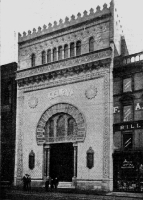
1914 Exterior
Courtesy of the
Gould Theatre Collection |
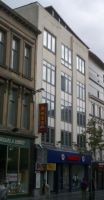
2004 Exterior
|
|
The
tall, narrow facade of the Salon would have been a striking
sight
when it opened in Sauchiehall Street in June 1913. At a time when
cinema architecture was still in its infancy, and tended to borrow
heavily from traditional theatre design, the Salon, attributed to
architect Thomas Baird Jr., would have looked like no other building in
Glasgow, cinema or otherwise. The entrance from the street was through
a large central door, framed by pillars at either side, with a massive
Moorish arch containing three windows above. The Moorish theme was
repeated over the rest of the facade, mostly clad in diagonally
set
square tiles, and framed, almost proscenium-like, by an elaborate band
of scrollwork.
Click here for a detail of the 1913 exterior plan.
|
The name was displayed centrally above the arch, and above the whole of
this was a full-width balcony, with even more elaborate scrollwork
adorning both its front, and above the 9 tall windows which looked onto
it. Finally, the roofhead was lined with a row of small castle-like
pediments, shaped like crosses, which continued around the sides.
| Inside,
the auditorium, seating 950 in stalls and balcony, appears to
have been at ground floor level, with a small foyer. The auditorium was
tall and narrow to make best use of the narrow
site. Above the auditorium, a remarkable cafe area was built,
which
continued the Moorish theme of the facade. At the northern end
of the
cafe, a tripartite archway echoed that of the main entrance, but
additionally featured the larger central arch being flanked by two
smaller ones at either side. Balconies overlooked the cafe on
either
side, these being split into small bays with curved balcony fronts
decorated with iron railings. Above, a barrel-vaulted ceiling provided
natural illumination with
large glazed portions in both that and the external roof above, the
interior glazing being coloured. The whole cafe area was
advertised as
a Winter Garden and Tea Lounge, so presumably the whole area was decked
out with exotic plants and shrubs. |
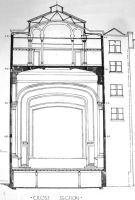
Tall, narrow auditorium with double-level
tearoom above
|
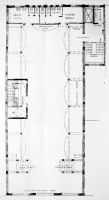
Tearoom plan - note curved projecting balcony
fronts
|
|
The cinema operation does not
appear to have been very successful, with the building gaining
something of an ill-reputation, and it is reported to have closed after
less than 10 years of operation, in May 1923 [1]. The
fate of the cinema after that is detailed in a rather vague and
confusing set of plans dated 1924/5 [2]. These
include plans of the building as it was at that point, as well as the
proposed plans for its conversion for retail use. Some of these
are intriguingly attributed to a W. Inglis – could this have been
Glasgow architect William Beresford Inglis, designer of the Beresford
Hotel, and several atmospheric
cinemas in the city, including the Toledo
in Muirend?
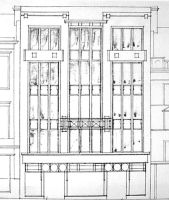
1925 Exterior Plan
|
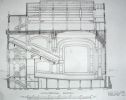
1913 Cross-section showing stalls &
balcony configuration
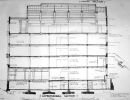
1925 Cross-section with three extra floors
|
|
The
facade of the building was totally altered into a more
traditional
frontage for the period, finished in plain white masonry, and split
vertically by three narrow glazed sections running almost to the full
height of the facade. Small balconies adorned the outer two of
these
sections at the upper-most level. The plans from these alterations also
show the central entrance being replaced by a small arcade, with a
central glass display case, but a photograph of 1937 [5]
(when the ground
floor was occupied by Cooks furniture shop) shows a single, more
conventional recessed doorway in the center, flanked by two large glass
displays. The 1937 photo also shows a new close formed at the
left of
the ground floor, which provided access to both a lift and small
staircase to
the upper floors. This appears on only some of the 1924/5 plans,
seemingly having been a late addition to them. The more elaborate main
staircase, which had previously provided access to the cinema balcony,
was swept away in these conversions. |
Sadly, the cinema auditorium
itself was also obliterated at this time, with the stalls floor leveled
and three new floors inserted above it. The cafe and Winter
Garden, however, seems to have escaped lightly, and this area survives
today as the least altered part of the original 1913 design.
The alteration plans have the name “Lumley” as the commissioner, and
after the conversion, the building seems to have taken the name Lumley
House. Interestingly, an early photograph of the cinema when it
was still in use [3] show Lumley’s to be the adjacent
premises, above what is now Lauder’s pub. This would suggest that they
took the opportunity to expand when the cinema became vacant. The top
floor cafe area, however, appears to have been a separate
concern, and is shown in photographs in the 1930s as The Piccadilly
Club [4]. This was entered from the newly formed
close at the ground floor, and is also advertised on signage at the
rooftop level.
The history of the building after the 1930s is, ironically, less
well-documented. As of October 2004, the ground floor is occupied by a
Rangers store. A Chinese restaurant is on the first and second floor
levels. A nightclub, now called Moon, has been operating from the upper
floors for many years now, although its older name of Rooftops is still
displayed in the windows. This uses the uppermost of the 1920s inserted
floors, as well as the two level original tearoom. As has been the case
since the mid-20s, access to the upper floors is still from the close
at the side of the ground floor, where the staircase winds its way up
around a lift shaft.
| It
has previously been thought that no original decoration from the
cinema was intact, but thanks to dedicated efforts of the staff in
the nightclub, some surprising survivals have come to light! On the
lowest level occupied by the club (which is on the uppermost of the new
levels built in the 20s), a false ceiling hides a rather unusual
ceiling of decorated panels made from what appears to be pressed copper
or brass. This level would have been the original
auditorium ceiling, but it is not clear whether these panels are from
then, or date from the 1920s alterations. Best of all, however, the
upper
club floors now occupies the space where the cafe once was – and
this
area has much of interest going back to the original 1913 design, if
one is prepared to look beyond the gaudy mirrored tiles and lights of
the current decor! |
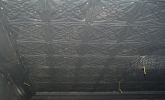
Pressed metal ceiling at original
auditorium ceiling level
|
|
As mentioned, this area was The Piccadilly Club in the 30s, and is also
said to have been a casino at some later point. Amazingly, it still
retains the balconies at either side, and the upper bays have curved,
decorative metal railings, although it is unclear whether these are
from 1913, or the later 1920s rebuild. Pillars in this area also sport
highly decorated tops, including two supporting an otherwise plain arch
at the southern end.
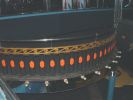
Balcony front detail
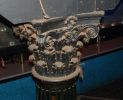
Pillar top detail
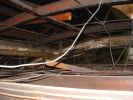
Original curved roof trusses of glazed roof portion
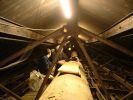
Void between the two glazed roof tiers
|

Moorish-style archways
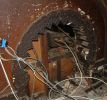
Archway detail

Archway base detail
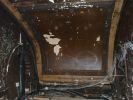
Surviving ceiling portion
|
|
Once
again, though, it is above false ceilings that the best evidence
is found. At the northern end, a magnificent, parallel pair of Moorish
arches are still to be found, hidden behind wooden paneling and the
clutter of modern electrical wiring. A larger central arch strongly
echoes the original Moorish arch on the facade, although this
one is
much more detailed, lined internally with a double row of teeth, and is
flanked by two similar, smaller arches. Presumably this would
originally have been mirrored by similar arches at the southern end,
where the now plain archway is. In between the two northern sets of
arches, a small portion of the barrel-vaulted ceiling also survives,
lined with decorated panels. Tantalising glimpses of the decoration
that must have once continued down to floor level are also visible. As
for the main, glazed ceiling of the cafe area, sadly this has
largely
been destroyed. All around the roof void bubbled paint, charred timbers
and melted
lead attest to the destruction of this ceiling by fire at some unknown
point, although the main curved plaster ribs are still in situ, and
appear to show signs that they once had small, decorative features
attached to them. Even some coloured glass is still evident in the
corners of some of the roof trusses, although the main exterior roof
glazing has been painted over and covered with metal sheeting since the
fire.
Externally, the facade of 1924/5 has been simplified further at
some
more recent point, with modern glazing introduced, and the twin mini
balconies at the top of either side removed, with the result that the building
today has changed so dramatically
from its original appearance that unless you look up and see the high
peaked roof of the auditorium, you
would never guess that it was once one of Glasgow’s earliest, most
individual cinemas.
|
A large gallery of photos from various parts of the interior of the
Salon may be seen here.
References
1. One Hundred Years of Glasgow's Amazing
Cinemas, Bruce Peter, Polygon 1996, ISBN: 0748662103
2. 1924/5 Building Plans, courtesy of Moon
Nightclub
3. Glasgow City Archives – Photo Collection –
C1223 (Salon as cinema, c1913)
4. Glasgow City Archives – Photo Collection –
C6977 (Lumley House, c1930)
5. Glasgow City Archives – Photo Collection –
C6980 (Cook's shop unit, c1937)
Many thanks to Sandy Forbes and the Moon Nightclub management and staff
for their time and enthusiasm!
|















